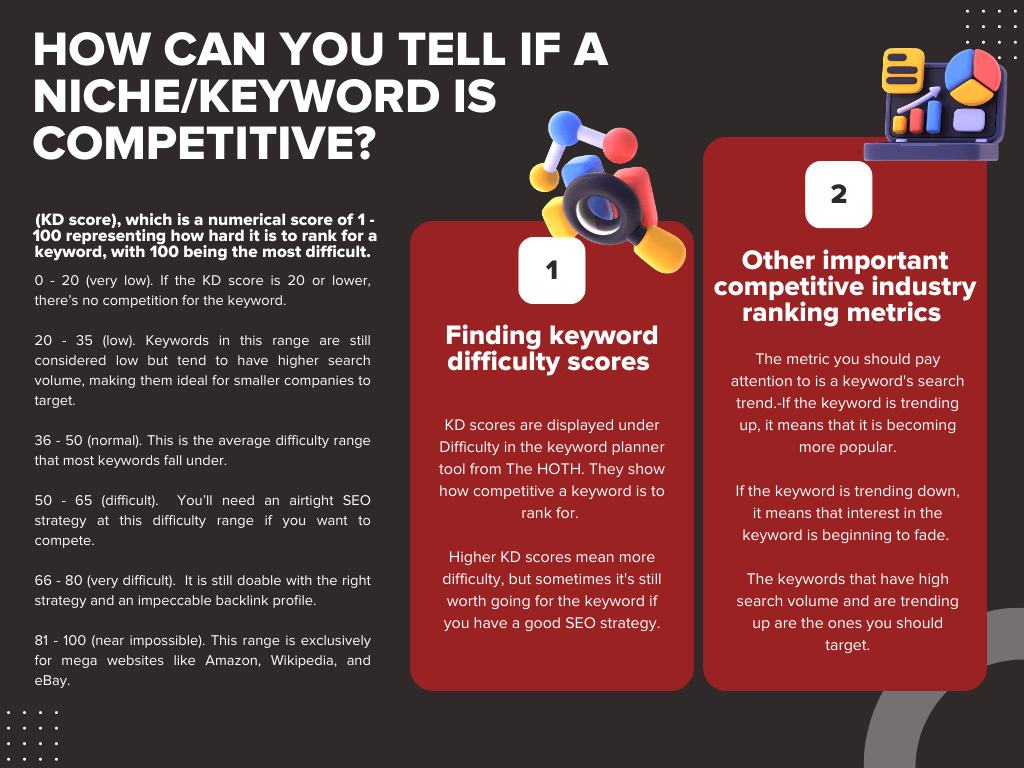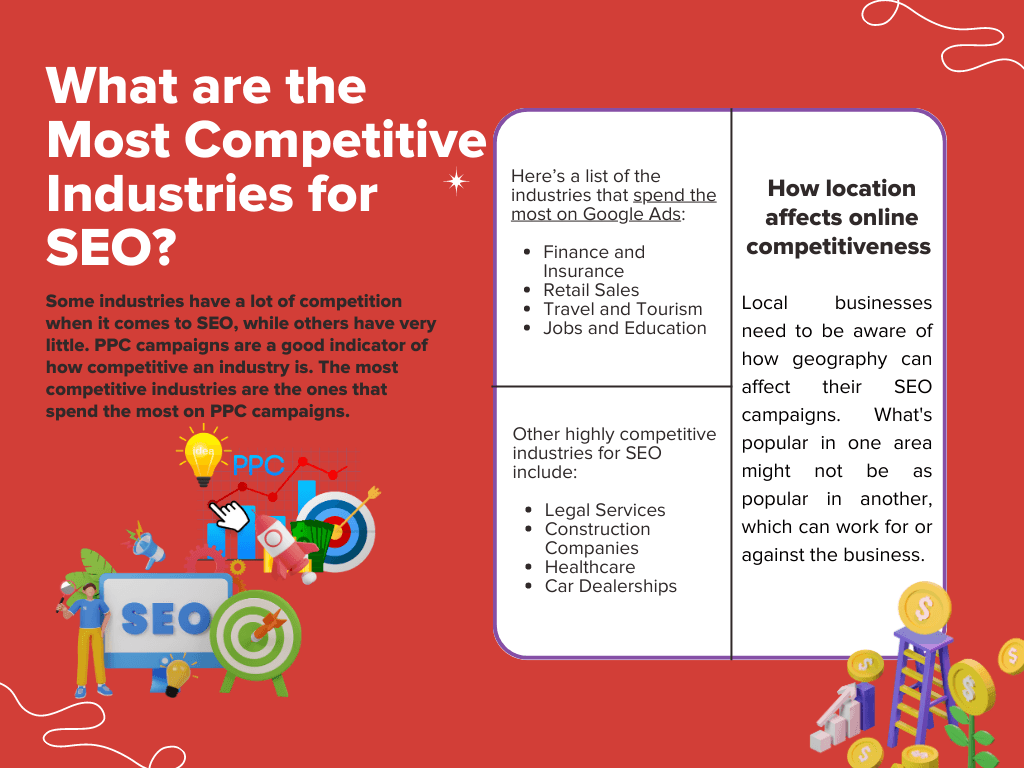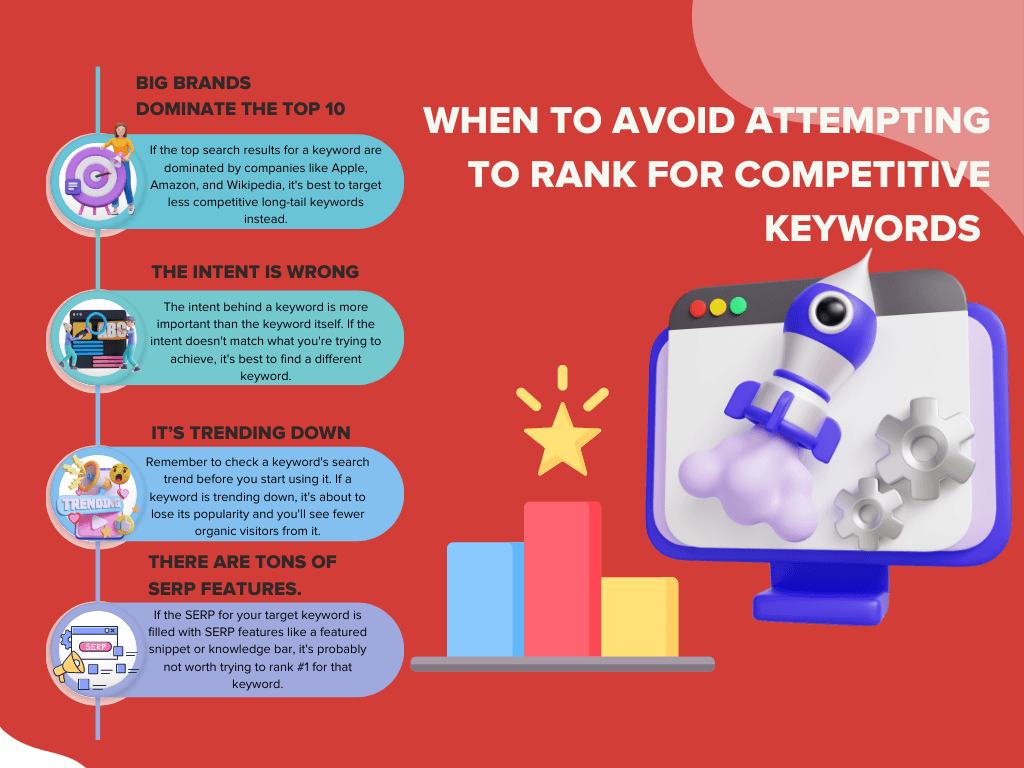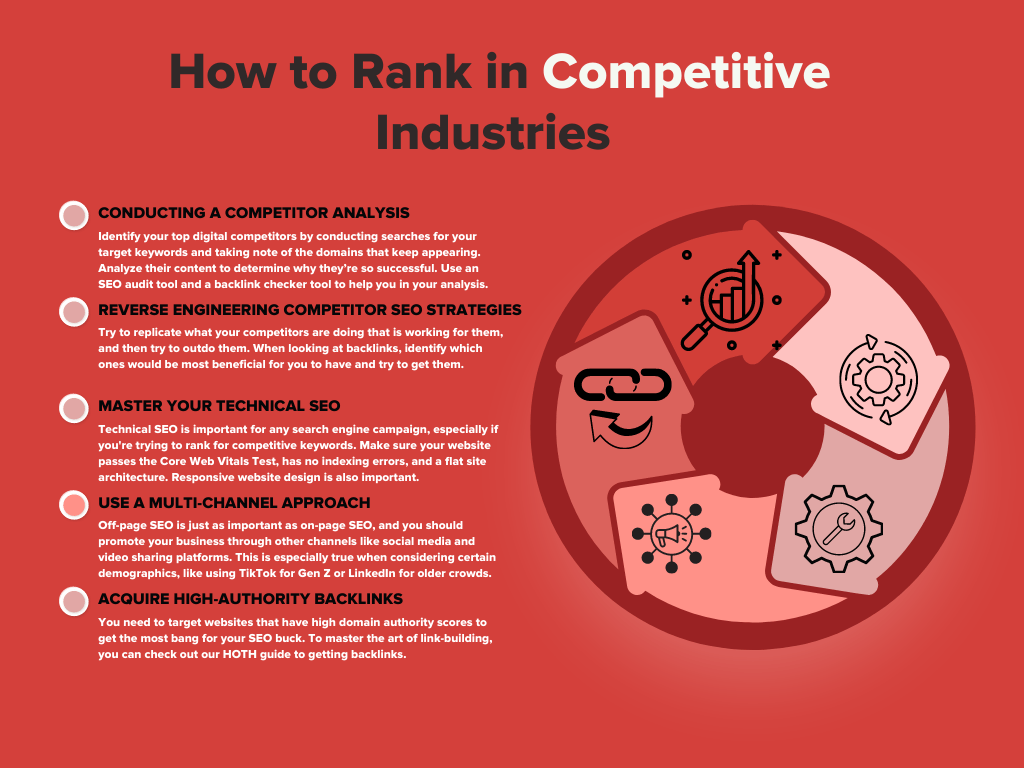It’s no secret that SEO is one of the most effective ways to market a business online, as organic & local searches on engines like Google account for 69% of all digital traffic.
Additionally, search engines direct 300% more traffic to content websites than social media channels.
So if you want to increase your leads & sales while boosting your overall online visibility – SEO is the way to go.
The catch?
Since SEO is so effective, it’s also extremely widespread – and many competitive industry rankings are practically set in stone. The companies that dominate the SERP rankings for their niches tend to have loads of high-quality content, flawless technical SEO, and impeccable backlink profiles.
That means it’ll be incredibly tough to rank in top spots for keywords in competitive niches like finance, real estate, law, and others.
This causes many small-to-medium-sized businesses to shy away from high-value keywords that have lots of competition.
Instead, they focus on keywords that have decent search volume and don’t have too many competitors.
But is this always the best approach to take?
Not always.
The truth is there are plenty of ways to snag top spots on highly competitive SERP pages; you just need to get creative with your tactics.
So instead of getting intimidated by high volume, high-difficulty keywords – stay tuned to learn how you can obtain competitive industry rankings without blowing your budget.
How Can You Tell if a Niche/Keyword is Competitive?
First, you need to know how to identify which industries & keywords have high amounts of competition and which don’t.
There are several ways to do so, the most common of which is to check a keyword’s difficulty score (KD score), which is a numerical score of 1 – 100 representing how hard it is to rank for a keyword, with 100 being the most difficult.

Here’s a quick breakdown of what each score range means:
0 – 20 (very low). If the KD score is 20 or lower, there’s next to no competition for the keyword. While it’ll be easier to rank, the search volume for these keywords is also likely very low.
20 – 35 (low). Keywords in this range are still considered low, but they tend to have higher search volume, making them ideal for smaller companies to target.
36 – 50 (normal). This is the average difficulty range that most keywords fall under.
50 – 65 (difficult). Here’s where things start to get interesting. At this difficulty range, you’ll need an airtight SEO strategy if you want to compete. This is also the range that we’ll be discussing in this article.
66 – 80 (very difficult). Things start to become dicier at this range, but ranking is still doable with the right strategy and an impeccable backlink profile.
81 – 100 (near impossible). This range is exclusively for mega websites like Amazon, Wikipedia, and eBay.
Finding keyword difficulty scores
Where can you find a keyword’s difficulty score?
Our keyword planner tool from The HOTH will display the KD score for any keyword you want, and it’s entirely free to use.
All you need to do is enter a keyword related to your niche, and the tool will provide you with a long list of relevant keywords.
Alongside each query, you’ll get to see its KD score.
As an example, let’s do a basic search for a competitive industry keyword like ‘real estate.’
Here’s a glimpse of the results:
Alt tag: Competitive industry ranking for the keyword ‘real estate.’
As you can see, the KD score for each keyword is displayed under Difficulty.
Also, note the exceptionally high difficulty scores for these keywords, a sign of the competitiveness of real estate SEO.
Out of these keywords, ‘real estate social network’ (39) and ‘compass real estate’ (50) show the most promise as far as KD score & search volume goes.
Should you avoid any keyword that has a KD score at or over 70?
Not necessarily.
While the KD score is an accurate assessment of how hard it is to rank for a query, it’s not infallible, and sometimes ranking for a keyword isn’t as difficult as you might think.
If you have a creative SEO strategy to employ and you want to take advantage of high search volume, don’t let a higher KD score intimidate you.
Other important competitive industry ranking metrics
Besides difficulty, another essential metric to pay attention to is a keyword’s search trend.
This is a line graph that represents the interest in a keyword over time. In particular, you should pay attention to the direction the line points at the end. If it’s pointing up, it’s a sign that the keyword is growing in popularity. If it’s pointing down, interest in the keyword is beginning to fade.
Ultimately, keywords that have high search volume and are trending up are the ones you should target.
Another metric that’ll help you gauge the competitiveness of a keyword is its CPC (cost-per-click).
This lets you know the average cost of a keyword in the PPC (pay-per-click) market.
Most of the time, the higher the CPC, the more competition there is to rank for a keyword – as it’s a case of supply and demand.
So if you want to get the most realistic view of a keyword’s competition, pay attention to both its KD score and its CPC.
If you notice that a keyword has a super high KD score but a very low CPC, one of the metrics may be unreliable – which may be a sign that the keyword isn’t as difficult to rank for as its KD score would imply.
What are the Most Competitive Industries for SEO?

Some industries and sub-markets have more SEO competition than others, which can be a good or a bad thing, depending on the context.
For instance, if a niche doesn’t have much competition online, it could be that A) it’s a newer industry that’s just starting to catch on, and you’re an early adopter (a good thing), or B) that there’s simply not much interest in the topic (a bad thing).
However, there’s no denying that the industries with the most competition have no shortage of organic visitors to pass around.
The problem lies in the fact that most of those organic visitors will go to the top few results on the SERPs, leaving everyone else hanging in the wind.
Which industries are the most competitive on search engines?
To find out, let’s take a look at which industries spent the most on PPC campaigns. This is a good indicator of competition because most companies only use PPC whenever their organic efforts aren’t yielding results – which is usually a sign of steep competition.
Besides that, PPC campaigns are popular for appearing above the organic SERP results, which is another sign that the industry is fiercely competitive.
Here’s a list of the industries that spend the most on Google Ads:
- Finance and Insurance
- Retail Sales
- Travel and Tourism
- Jobs and Education
Other highly competitive industries for SEO include:
- Legal Services
- Construction Companies
- Healthcare
- Car Dealerships
If your business falls into one of these industries, you’ll likely have no shortage of competitors trying to rank for the same keywords.
How location affects online competitiveness
Local businesses face an additional challenge when launching SEO campaigns – which is how geography can affect competition.
What do we mean by that?
What’s popular in one area might not be as popular in another, which can work for or against you.
Let’s say that you run a vegan sushi restaurant in Portland, OR.
Well, the popularity of the keyword ‘vegan sushi’ is bound to be a lot higher in Portland than somewhere like Kansas or Oklahoma.
If you’re running a vegan sushi spot in Kansas, the good news is that you won’t have much in the way of competition.
Yet, if you are in Portland, OR, you’ll face tougher competition trying to rank for that keyword than you would somewhere else.
When to Avoid Attempting to Rank for Competitive Keywords
While this article is all about standing strong against competitive industry rankings, sometimes being brash isn’t the move to make.

There are a few instances where you should skip over keywords entirely in favor of other queries, including the following:
- Big brands dominate the top 10. If the top results for a keyword are dominated by the likes of Apple, Amazon, and Wikipedia – your best bet is to fold your hand. In this situation, you’re better off targeting long-tail keywords with less competition.
- The intent is wrong. Even if a keyword has outstanding metrics, if the search intent isn’t what you’re going for, it’s best to avoid it. For instance, if you thought the intent was commercial, but it’s actually navigational, you should target a keyword that is actually commercial instead.
- It’s trending down. Remember to pay attention to a keyword’s search trend, either by using our keyword planner or checking Google Trends. If a keyword has high search volume & high competition but is trending down, it’s about to lose its popularity – and you’ll see fewer and fewer organic visitors from it.
- There are tons of SERP features. Is the SERP for the keyword you’re targeting riddled with SERP features like a featured snippet, image carousels, and a knowledge bar? If so, then even the #1 organic spot is getting overshadowed by the SERP features in position zero, so steer your efforts elsewhere.
If you notice any of these red flags, you should abandon ship and research other keywords instead.
How to Rank in Competitive Industries

So far, we’ve talked a lot about overcoming steep competition to rank higher online, but how do you actually do that?
It’s time to learn how to develop a rock-solid SEO strategy that will lead to higher rankings, even in competitive niches.
In particular, you need to do the following:
- Closely analyze your top competitors to pinpoint why they’re so successful
- Reverse engineer their success for your own benefit
- Employ impeccable technical SEO
- Create outstanding content that your audience wants to consume
- Promote your business across multiple channels
- Bolster your backlink profile
These are all critical factors for your SEO success, so let’s take a closer look at each one.
Conducting a competitor analysis
Your first step should be to size up your top digital competitors.
Note the word digital here, as your online competitors won’t always be the same as your physical competitors.
For example, some of your top brick-and-mortar competitors may not even have an online presence, so they won’t cause you any trouble in your SEO pursuits.
However, there will be other companies out there (that you’ve probably never heard of) that will have a stranglehold on your niche.
These are the companies that you want to pinpoint and analyze.
How do you find them?
It’s a long process, but it typically goes like this:
- Conduct searches on Google (and other search engines included in your campaign) for your target keywords (yes, all of them)
- Write down the businesses that appear in the top 5 results
- Rinse and repeat for your next set of keywords
- Take note of the domains that keep appearing, as they’ll be your top competitors
Once you’ve found your primary competitors, you’ll need to analyze their content to determine why they’re so successful.
Do they consistently publish thought leader-level content for their audience? Do they have excellent technical SEO and keyword placement? Do they have an impressive backlink profile?
These are all essential questions to ask when analyzing competitor content.
Also, don’t forget to use our SEO audit tool to deeply analyze your top competitors. Our backlink checker tool also comes in handy for viewing a domain’s backlinks (which you can attempt to poach).
Reverse engineering competitor SEO strategies
Once you know why a competitor is doing so well on the SERPs, there’s no law saying you can’t replicate their success.
If they’re publishing high-quality content that audiences trust, try to identify ways that you can not only publish similar content but also outdo them.
Tips for outdoing competitor content include:
- Creating detailed infographics for the topic
- Adding original insights and tips that aren’t present in the original piece
- Using more high-resolution images that directly relate to the topic
- Shooting a helpful video that goes into more depth than the original post
These are all ways that you can create fantastic content that outdoes your competition.
Also, when taking a look at a competitor’s backlink profile, identify the links that have the most impact – i.e., the ones coming from domains with high authority.
If you find backlinks that you know will boost your own profile, you can attempt to snag them for yourself.
If you’ve already created a piece of content that outdoes the original piece they linked to, a webmaster is likely to link to your piece of content instead – as that will benefit their SEO, too.
Master your technical SEO
Technical SEO is important for any search engine campaign, but it’s doubly crucial when attempting to rank for competitive keywords.
That’s because the increased competition will greatly reduce your margin for error.
If you want to reach the top of the SERPs for a competitive keyword, you can’t have any indexing errors, slow loading times, or a poorly structured website.
To refresh your technical SEO chops, you can check out our extensive technical SEO checklist.
Here’s the condensed version:
- Your website needs to pass the Core Web Vitals Test (page speed)
- Google Search Console’s Indexing Report will help you resolve any crawling/indexing errors
- A flat site architecture works best (where every page is a few links away from the homepage)
- Responsive website design works best as it can display on both desktops and mobile devices
- Website security is a must (HTTPS and SSL certificates)
Use a multi-channel approach
Off-page SEO matters, too, so you shouldn’t neglect to promote your business through other channels.
In particular, social signals affect SERP rankings, so you should have a presence on all the major social channels (Facebook, Instagram, Snapchat, etc.).
That’s especially true when considering certain demographics, such as using TikTok to appeal to Gen Z and LinkedIn for Gen X and older crowds.
Creating content for video-sharing websites like YouTube is another way you can build your online reputation and drum up traffic for your site.
So, in addition to posting regular blog content, you should also post on social media sites, video-sharing platforms, and more.
Acquire high-authority backlinks
If your SEO campaign primarily revolves around Google, then link-building needs to comprise a large portion of your strategy.
Backlinks don’t matter as much for search engines like Bing & Yahoo, but they will still boost your online visibility to a degree.
You need to target websites that have high domain authority scores to get the most bang for your SEO buck.
To master the art of link-building, you can check out our HOTH guide to getting backlinks.
Here are some quick link-building tips and tactics:
- You can target link insertions by reaching out to webmasters to insert backlinks into their existing pieces of content.
- Guest blog posting is a popular way to obtain backlinks.
- Replacing broken links online is a white-hat tactic for acquiring links.
- Getting listed on directories like Yelp will generate backlinks.
The stronger your link profile is, the stronger your chances are of ranking higher on Google.
Final Thoughts: Competitive Industry Rankings
Certain industries have more competitive SEO than others, but that doesn’t mean that you can’t reach the top of the SERPs.
By analyzing, copying, and outdoing your competitors, you can claim your rightful spot in the top 5 results on search engines like Google and Bing.
Improving your link profile and creating outstanding content will also help your chances.
Does your business need help penetrating the top SERP results for your competitive industry?
Then don’t wait to check out our HOTH X, our SEO service customized for you. Our experts will help you gain a loyal following of brand evangelists, so don’t wait to get in touch today.
